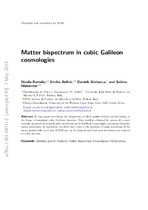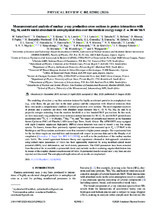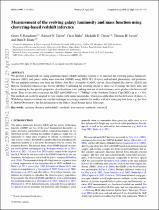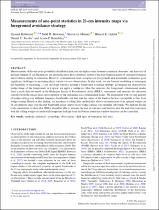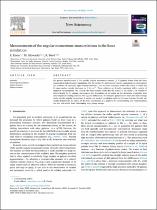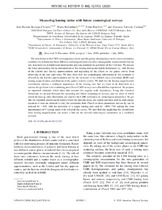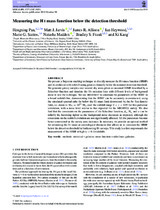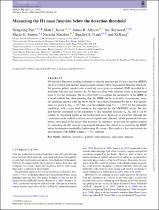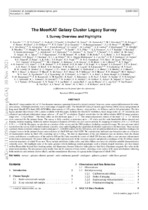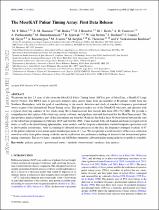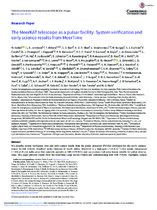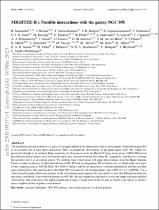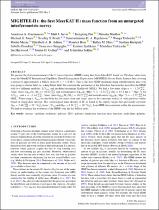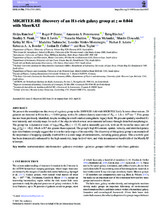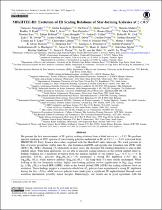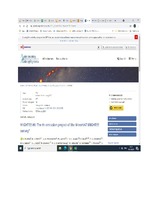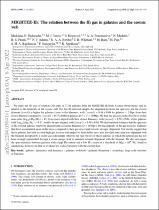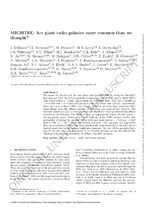Browsing Research Articles (Physics) by Title
Now showing items 280-299 of 510
-
Matter bispectrum in cubic Galileon cosmologies
(IOP Science, 2013)In this paper we obtain the bispectrum of dark matter density perturbations in the frame of covariant cubic Galileon theories. This result is obtained by means of a semi- analytic approach to second-order perturbations ... -
Maximum sprite streamer luminosity near the stratopause
(AGU Advances, 2019)Sprites are composed of numerous streamers which exhibit transient luminosities in the upper middle atmosphere above thunderclouds after initiation by an intense positive lightning discharge, often followed by lightning ... -
Measurement and analysis of nuclear γ-ray production cross sections in proton interactions with Mg, Si, and Fe nuclei abundant in astrophysical sites over the incident energy range E = 30–66 MeV
(American Physical Society, 2020)The modeling of nuclear γ -ray line emission induced by highly accelerated particles in astrophysical sites (e.g., solar flares, the gas and dust in the inner galaxy) and the comparison with observed emissions from these ... -
Measurement of the evolving galaxy luminosity and mass function using clustering-based redshift inference
(Monthly Notices of the Royal Astronomical Society, 2023)We develop a framework for using clustering-based redshift inference (cluster-z ) to measure the evolving galaxy luminosity function (GLF) and galaxy stellar mass function (GSMF) using Wide-field Infrared Survey Explorer ... -
Measurements of one-point statistics in 21-cm intensity maps via foreground avoidance strategy
(Oxford University Press, 2022)Measurements of the one-point probability distribution function and higher-order moments (variance, skewness, and kurtosis) of the high-redshift 21-cm fluctuations are among the most directstatistical probes of the ... -
Measurements of the angular momentum–mass relations in the Simba simulation
(New Astronomy, 2023)We present measurements of the specific angular momentum content (𝑗) of galaxies drawn from the Simba cosmological hydrodynamic simulations. These relations are broadly consistent with a variety of empirical measurements. ... -
Measuring lensing ratios with future cosmological surveys
(American Physical Society, 2020)The ratio between the CMB lensing/galaxy counts and the galaxy shear/galaxy counts cross-correlations combines the information from different cosmological probes to infer cosmographic measurements that are less dependent ... -
Measuring the H I mass function below the detection threshold
(Oxford University Press, 2019-10-30)We present a Bayesian stacking technique to directly measure the H I mass function (HIMF) and its evolution with redshift using galaxies formally below the nominal detection threshold. We generate galaxy samples over ... -
Measuring the HI mass function below the detection threshold
(Royal Astronomical Society, 2020)We present a Bayesian stacking technique to directly measure the H I mass function (HIMF) and its evolution with redshift using galaxies formally below the nominal detection threshold. We generate galaxy samples over several ... -
The MeerKAT Galaxy Cluster Legacy Survey: Survey overview and highlights
(University of the Western Cape, 2022)MeerKAT’s large number (64) of 13.5 m diameter antennas, spanning 8 km with a densely packed 1 km core, create a powerful instrument for wide-area surveys, with high sensitivity over a wide range of angular scales. The ... -
The MeerKAT pulsar timing array: First data release
(Oxford University Press, 2022)We present the first 2.5 years of data from the MeerKAT Pulsar Timing Array (MPTA), part of MeerTime, a MeerKAT Large Survey Project. The MPTA aims to precisely measure pulse arrival times from an ensemble of 88 pulsars ... -
The MeerKAT telescope as a pulsar facility: System verification and early science results from MeerTime
(2020)We describe system verification tests and early science results from the pulsar processor (PTUSE) developed for the newly commissioned 64-dish SARAO MeerKAT radio telescope in South Africa. MeerKAT is a high-gain ( ) ... -
Mergers, starbursts, and quenching in the SIMBA simulation
(Oxford Academic, 2019)We use the SIMBAcosmological galaxy formation simulation to investigate the relationship between major mergers (4:1), starbursts, and galaxy quenching. Mergers are identified via sudden jumps in stellar mass M∗ well above ... -
Mightee-h i: Possible interactions with the galaxy NGC 895
(Oxford University Press, 2023)The transformation and evolution of a galaxy is strongly influenced by interactions with its environment. Neutral hydrogen (H i) is an excellent way to trace these interactions. Here, we present H i observations of the ... -
MIGHTEE-H I: the first MeerKAT H I mass function from an untargeted interferometric survey
(Oxford University Press, 2023)We present the first measurement of the H I mass function (HIMF) using data from MeerKAT, based on 276 direct detections from the MeerKAT International GigaHertz Tiered Extragalactic Exploration (MIGHTEE) Survey Early ... -
MIGHTEE-HI: discovery of an HI-rich galaxy group at z = 0.044 with MeerKAT
(Monthly Notices of the Royal Astronomical Society, 2021)We present the serendipitous discovery of a galaxy group in the XMM-LSS field with MIGHTEE Early Science observations. 20 galaxies are detected in HI in this z ∼ 0.044 group, with a 3σ column density sensitivity of NHI = ... -
Mightee-hi: Evolution of hi scaling relations of star-forming galaxies at z < 0.5*
(IOP Publishing, 2022)We present the first measurements of H I galaxy scaling relations from a blind survey at z > 0.15. We perform spectral stacking of 9023 spectra of star-forming galaxies undetected in H I at 0.23 < z < 0.49, extracted ... -
MIGHTEE-HI: The H » i emission project of the MeerKAT MIGHTEE survey
(EDP Sciences, 2021)We present the H » I emission project within the MIGHTEE survey, currently being carried out with the newly commissioned MeerKAT radio telescope. This is one of the first deep, blind, medium-wide interferometric surveys ... -
MIGHTEE-Hi: The relation between the Hi gas in galaxies and the cosmic web
(Oxford University Press, 2022)We study the 3D axis of rotation (3D spin) of 77 Hi galaxies from the MIGHTEE-Hi Early Science observations, and its relation to the filaments of the cosmic web. For this Hi-selected sample, the alignment between the spin ... -
MIGHTEE: Are giant radio galaxies more common than we thought?
(Oxford University Press, 2021)We report the discovery of two new giant radio galaxies (GRGs) using the MeerKAT International GHz Tiered Extragalactic Exploration (MIGHTEE) survey. Both GRGs were found within a ∼}1\, deg2 region inside the COSMOS field. ...

